HAARP Reception: 2008 January
19-20
back to Advanced
Operations
2008 January 26, cbd
An announcement came
out that the HF Active Auroral Research Program (HAARP) would be doing
EME experiments on the evenings of 2008 January 18 and 19 (19 and 20
UTC) when the sunspots were near minimum and the moon was as high over
Alaska as it gets. A remarkable feature of these tests was the
two frequencies used, bracketing the amateur 40 meter band.
The format was similar to the DSP-10's EME2 mode. Transmit a
steady carrier for two seconds then listen for three seconds, expecting
a return during the two seconds from 2.575 to 4.575 seconds after the
beginning of transmission, repeating this cycle every five
seconds. Amateurs and Short Wave Listeners were invited to
participate and send in signal reports.
Equipment used at n5bf/6: Kenwood TS-680, connected
to a GAP Voyager DX-IV
vertical. My experience is that this GAP performs best on 40
meters, at least for low radiation angle DXing. For this test,
however, the moon was in the 75-85 degree elevation range, where
response is likely down by 5-10 dB or more. Direct signals from
Alaska via the ionosphere were expected to be nominal.
2008 January 19 UTC (the 18th
local)
0526 UTC: Listened for
about five minutes on 6.7925 MHz, noting that I was hearing the HAARP
transmissions from 0-2 seconds every five seconds, verified against a
WWVL synchronized clock. These transmissions were S-9 to S-9+5 in
S-7 noise. Heard no lunar echos.
0648 UTC: Listened
briefly on 7.4075 MHz and heard only a local S-9 noise source spanning
about 2 KHz. No HAARP transmissions or echos copied.
Saturday morning, local, egged on by Argo plots from K0TY in my
inbox, I decided to make a better effort on the second evening.
2008 January 20 UTC (evening of
the 19th local)
0330 UTC:
Hunted half an hour for my SignaLink Model SL-1
which provides the electrical interface between radio audio circuits
and sound card audio I/O.
Fired up Virtual PC (VPC) on the PowerBook G-4. Yes, Argo was
already there. Configured it.
Corrected the "audio in" mistake I had made on a similar occasion
before. Just plugging something into the mic. input on the G4
doesn't cause it to automatically switch to utilize it, the computer
continues to use its internal microphone. This can be confusing
since that microphone picks up the sounds coming out of the speaker of
the rig just fine, albeit with local shack noise added.
Nonetheless, I nearly made a PSK-31 QSO in this way once before
realizing that I needed to go to System Preferences and switch to the
external mic. Did this and verified room noise extinguished.
Printed out one of the K0TY pictures and futzed around for a while
trying to get similar Argo settings.
Verified that I could run InstanTrak (a PC-based graphic satellite
tracking program written by Franklin Antonio, N6NKF and distributed by AMSAT) in
tabular update mode while running Argo, all under VPC. Set the
"frequency for the moon" to 67.925 MHz, 10 X operational frequency so
as to get another digit (0.1 Hz) of precision in the Doppler
projections.
Also switched the bottom line of the DSP-10 to EME mode for
comparison. (DSP-10 computes Doppler for self echos or for self
to another station, but always at the live operating frequency since
this data is used for actual moonbounce operations within the
radio. 144.2 is about twenty times the HAARP frequencies.)
InstanTrak has my position as 34.212 north, 118.222 west, 400 meters
MSL. Also entered the HAARP position: 62.320 north, 145.151
west, in IT and the DSP-10 configuration file (for live comparison
only).
0615 UTC:
Came back to the computer and found that VPN was frozen up. The
PC had crashed. Killed and restarted it, re-establishing
InstanTrak and Argo as before.
0630 UTC:
Test begins on 6.7925 MHz. Watch the Argo screens and make
capture files throughout the experiment. Put a long time tick in
once in a while so as to see when it is time for another capture.
(Argo doesn't label the X-axis.) Captured a total of 32 files,
with names like 'haarp00032.jpg' Made notes in shack notebook
including times and capture file names, moon azimuth and elevation,
predicted Doppler, audible recpeption notes, and other remarkes.
The rig reads 6.792.500 CW which means the BFO is at 6.791.700 and the
sense is upper sideband with expectation of a 800 Hz CW note, transmit
and receive. In the past, the rig has been shown to be about 0.6
parts per million low in frequency plus or minus 0.2 ppm.
Tonight's results, the HAARP signals showing a few Hz above 800 Hz in
Argo, are consistent with this.
The first capture was not encouraging but does calibrate some of the
operational issues.
Times on the display captures are local, Pacific Standard Time, which
is UTC - 8 hours (prior day, in this case).
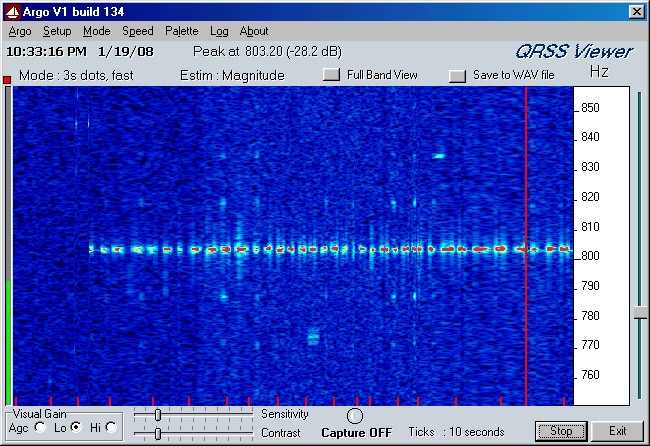
We see some jitter in Argo X axis as it scrolls with time, doubtless a
result of graceful degradation from insufficient CPU resources under
VPN and competing with IT. Other than that, we are seeing the
direct signals pretty much as expected but nothing off the moon.
If the Gap performance goes off with increasing elevation as a simple
cosine (unknown if it actually does, or what are the particulars of
this installation are), lunar reflections would have 6 dB or more of
relative loss. compared to, say, a horizontal dipole. (Of course
a horizontal dipole would have a lot of ground effect so its height
would be important in this application.)
The S-meter on the radio said S-7 for the HAARP signals and S-5 for the
noise. I usually notate this as "S-7/N-5."
Conditions Key: Time UTC | Moon Az / El., deg. | HAARP Doppler +
N5BF Doppler = total predicted Doppler, Hz
Conditions: 0636 | 239 / 78 | +0.5 - 2.1 = -1.6
This went on for several minutes and several captures without anything
really interesting happening and no sign of lunar returns. I was
determined after all that set up to stick it out for a while and see
what happened. (A null result is still science....)
Occasionally something anomalous would happen.
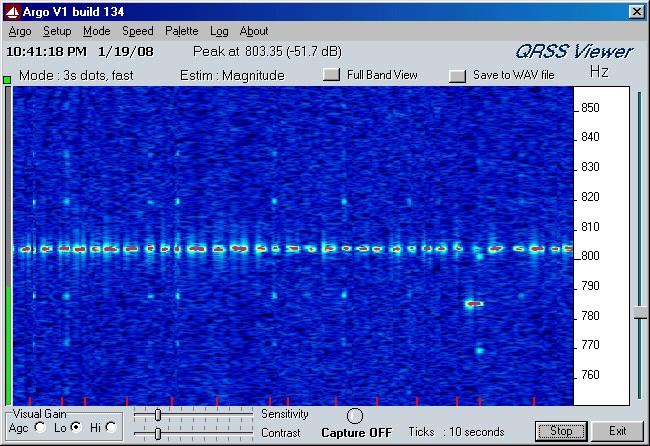
Did the signal really jump down 10 Hz on that one point? Was it
an equipment anomaly in the shack? QRM?
Then, I thought I might be seeing something.
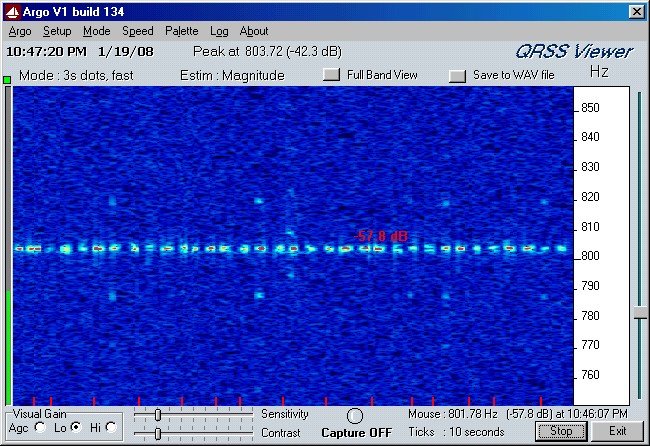
Are those faint "underlines" in the last few gaps to the right lunar
echos?
They are about 2 Hz below direct.
Conditions: 0645 | 244 /
76 | +0.3 - 2.4 = -2.1
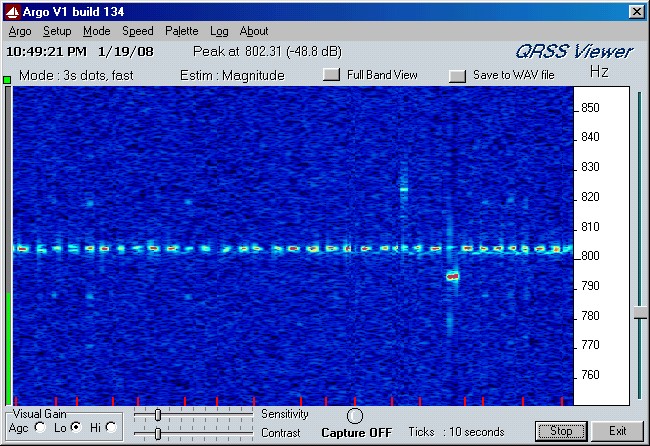
Yes, we're definitely seeing something that is improving with
time. And some more "anomalies." Also, I audibly heard a
few echos during this period.
0657. I have a 15/17/20 meter electrically parallel wire dipole
that used to hang over the house between two trees. We had tree
work done last fall and the antenna has been laying on the roof ever
since. It is still connected and is, however, horizontal so I
thought I'd try it. I immediately began copying the moon better
and HAARP worse. The switch is the darkish vertial line point on
the left of the capture.

Upon switching, the S-meter went to zero for both signals and
noise. Turned up the audio volume a little.
Yes, the returns
are further from the transmitted carrier. Doppler is increasing.
06:49:40 - 07:00:00 HAARP
signal QRT.
Results for the next half hour were similar. I wondered why the
lunar returns seemed to be cleaner signals than those via the
ionosphere. Weaker? Less ionosphere involvement?
Both? Switched antennas some more but ended up on the Gap mostly.
At 0720 I was seeing no reflections at all.
Conditions: 0720 | 255 / 71 | -0.2 -3.3 = -3.5
07:29:25 QRT at 6.7925. QSY to 7.4075.
Change the "moon frequencies" in InstanTrak and moved the radio to
display 7.407.500 CW. This should result in the same 800 Hz tones
as previously.
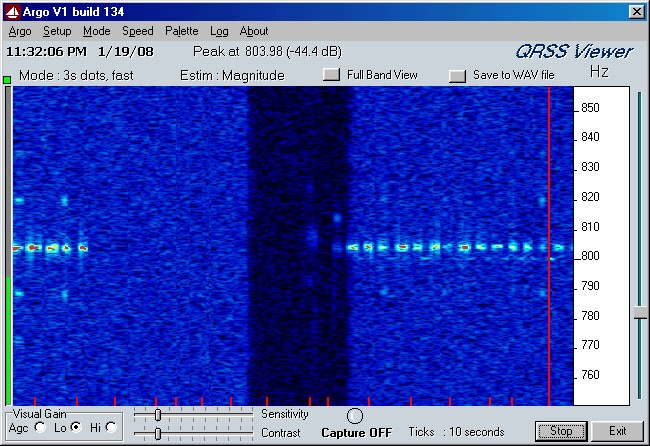
The big dark region in the middle is the switchover. On the new
frequency, I was seeing returns immediately. Note the larger
Doppler. Sometimes the "Peak at" reading (middle top) would show
a frequency for the return (here it shows the frequency of the
ionosphere signal). Returns were also 4.5 - 5 Hz lower than
direct.
Conditions: 0735 | 260 / 67 | -0.6 -4.2 = -4.8 (for the new
frequency)
Echo reception then improved markedly. Tonight, 7.4075 is the
better frequency.
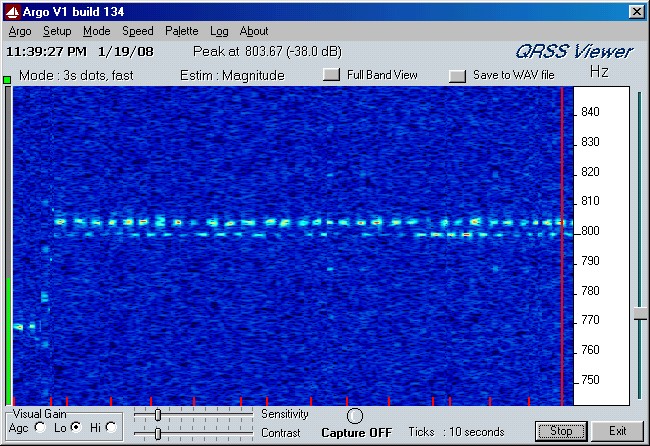
Notice a time about 3/4 of the way to the right when lunar returns were
louder than direct, which nearly faded out. These were audible.
The big frequency jump on the far left is when I recovered from a
bumped Argo dial. It's not really a frequency jump. The
scale jumps too.
Switching to the 15/17/20 dipoles on the roof at this point made the
signal dissapear completely.
Unable to stay up to the end of the test at 0830 (1230 a.m. local
preceding a Sunday morning commitment at 0830) I did hang on long
enough to capture a "Peak at" from the moon.
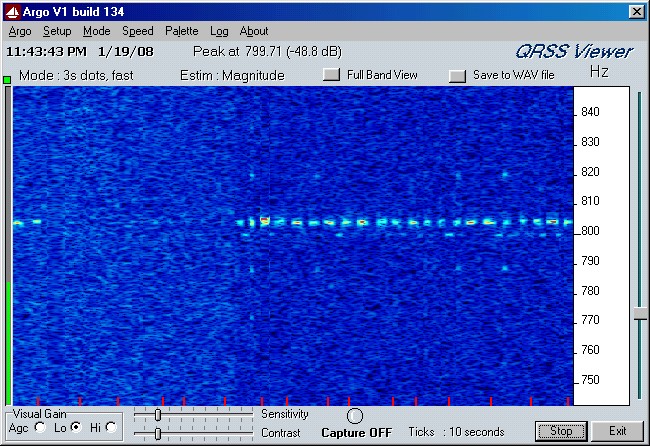
It shows about 4 Hz below the last-indicated direct signal above.
That's probably within the margin of fuzz, given the ionosphere, and
the technique. Note the 15/17/20 dipole period to the left.
Conditions: 0744 | 262 / 65 | -0.8 -4.5 = -5.3
And at that point I threw the big switch(es).
Discussion
I was first licensed in 1972 and built my first single tube transmitter
with which I had great Novice Sunday evening experiences on 40 meter
CW, despite its keying chirp of several hundred Hz. It is
remarkable to me that amateurs today, 35 years later, are able to do
things like this, seeing HF signals reflected off the moon in digital
displays with resolution of under a Hz, plenty to see the Doppler
effect of a lunar reflection!
(Technically these operations were at 40.5 and 44.1 meters.
Average is 7.100 MHz (amateur band) at, strictly speaking, 42 meters.)
The HAARP facility radiates 3.6 MW on 180 antennas. See
"Questions about the HF Transmitter and Antennas at http://www.haarp.alaska.edu/haarp/faq.html.
Presumably these are phased to aim the array at the moon or other
regions in the ionosphere for study.
W4EF asked if it might be possible to do this on 40 meters at amateur
power levels using a DSP-10 EME2 like
technique. Guessing that HAARP can peak around 88 dBWi (+118 dBm)
toward the moon and noting that a good
amateur station on 40 meters might approach 40 dBWi (+70 dBm), we have
nearly 50 dB to make up. The 10 dB gain 40 meter antenna in this
hypothetical station counts twice, so we only have 30 dB to make
up. This could be bridged with about a million seconds of
integration which would take at least three to four weeks of EME2 to
accumulate, given that the moon is up only half the time and in a
useful position less than that.
Looking over all
of my screen
captures, I might be able to claim detection from this 75 minute
experiment (my participation subset) for 10 dB less return signal, but
integrated over all that time. The
back-of-the-envelope conclusion is that this would be similar in
difficulty to Earth-Venus-Earth with an amateur EME class station on
VHF or UHF, feasible but requiring two or three obsessions. After
all, 10 dB on 40 meters is a big antenna for an amateur, and it would
have to be Az/El mounted. And, how many ham's full gallon
amplifiers could be cycled a million times and still work right?
(Maybe most, I don't know.) And, you'd either have to adapt EME2
to an existing transceiver, or adapt a DSP-10 to HF. None of
these are impossible, but they are big jobs and there are several of
them.
n5bf/6







